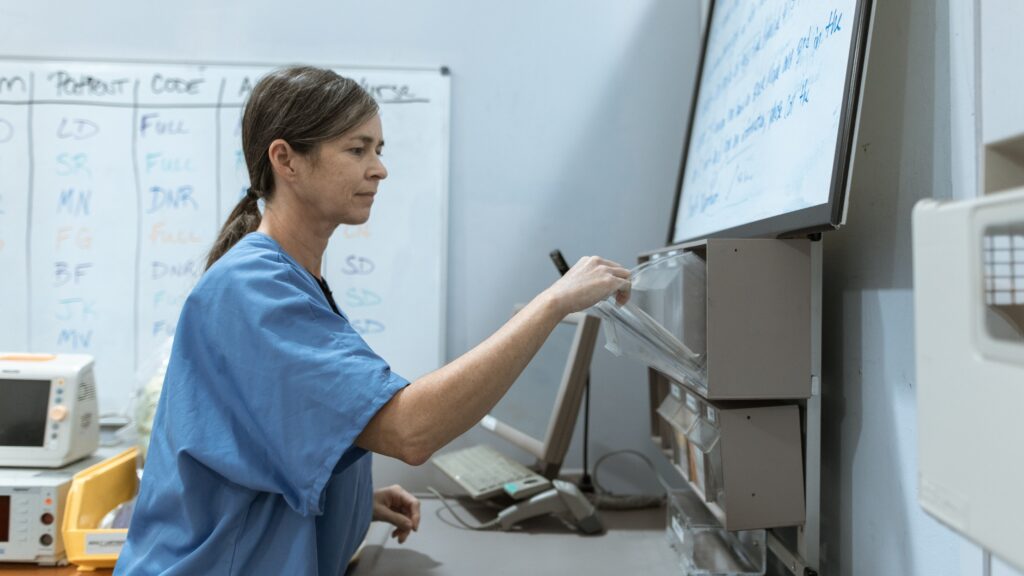
History
St Boniface Nurses Worksite 5

St Boniface Nurses Worksite 5
In the beginning…..
In 1968 the nurses at St. Boniface General Hospital (SBGH) were concerned and upset because nurses at Misericordia General Hospital and Victoria General Hospital had just completed negotiations which included increased pay and better working conditions.
St. Boniface General Hospital Nurses’ Association (SBGHNA) was certified and thereby established by the Manitoba Labour Board in October of 1969.
In preparation for certification the first general meeting to form the St. Boniface General Hospital Nurses’ Association (SBGHNA) took place on February 6, 1969 at the Norquay Building and our first Constitution was approved. At our second meeting on February 17, 1969 a list of Officers was elected. From that point a great deal of work needed to be done including numerous meetings in order to prepare for our certification application to the Manitoba Labour Board. Hard work, persistence and a great deal of cooperation from all nurses resulted in the successful certification of St. Boniface nurses on October 21, 1969. Our certification documents are kept at the Worksite 5 office.
Our first Annual meeting was held on February 29, 1970 at “Champs Motor Inn”. Tickets were $1.00 per person and Eaton’s gave a gift of a “cream sachet” for each person attending.
Our first Collective Agreement (contract) was signed on September 18, 1970 – it was a one-year agreement. Our negotiator was Jean Burrows, a teacher at the RN School.
One of the hardest tasks to be done at first was the collection of dues. Dues had to be collected from each nurse by each Ward Rep on a monthly basis. Dues were $1.00 per member, per month. The automatic payroll deduction of dues began in January of 1971.
In May of 1970 and provincial umbrella organization for nurses known as the Provincial Staff Nurses’ Council (PSNC) was established and SBGHNA became an associated member. SBGHNA dues to belong to the PSNC were 50¢ per member, per month, of the $1.00 per member, per month of dues collected.
After a long battle and many meetings, casual nurses were finally included in the Collective Agreement in 1973. Total number of casuals at that time was 130.
At the SGHNA Annual meeting in March of 1974, membership passed a motion to accept LPNs and RPNs into the Association. They became part of the Certification in October of 1974.
1975 “The Year of the Nurse”. This was the year that negotiations went to the 11th hour. Emotions and stress ran high. St. Boniface General Hospital was nearly empty. Families, patients and nurses were clinging to hopes that a settlement would be reached. Strike headquarters were established above what is now a restaurant beside the CIBC on Taché at Marion. A meeting for a strike vote was held at the no longer existing Club La Verendrye. Nurses were determined to improve their working conditions, employment status and salaries, which were far behind all other provinces. Nurses bonded together through this very difficult period and their strength in numbers and sheer determination brought about the largest monetary settlement in the history of Manitoba nurses – a 45% salary increase plus improved working conditions and benefits. On March 19, 1975 the Collective Agreement was ratified.
On October 15, 1975 the Provincial Staff Nurses’ Council became Manitoba Organization of Nurses’ Association (MONA).
In November of 1977 St. Boniface General Hospital Nurses’ Association became St. Boniface Nurses MONA Worksite 5. The “5” meant that we were the fifth Worksite to be certified in Manitoba.
In 1981 representatives from the St. Boniface Nurses MONA Worksite 5 were actively involved in the planning and founding of the National Federation of Nurses’ Unions (NFNU) now known as the Canadian Federation of Nurses’ Union (CFNU). Former Worksite 5 president Sonny Arrojado became the first president of the NFNU.
The growth of the St. Boniface Nurses MONA Worksite 5 was continuous and rapid. The number of meetings with hospital management that required representation from our Worksite, and the time it took to organize our own needs, placed heavy demands on our executive, and in particular our Worksite president. In 1981 the hospital agreed to give one day a week with pay to the Worksite president in order for the president to attend meetings. As well, MONA passed a resolution at the 1979 annual general meeting to give presidents of all Worksites paid days to do union business.
Worksite 5 grew and developed into a very strong and respected organization. The increased workload of the Worksite 5 office including representation for individual members, along with demands for representation on numerous committees gave rise to the need for a full-time president in 1989.
Originally the Worksite 5 office was located above the former Al’s Jewellers on Marion St. As the demands of membership increased and members increasingly sought more convenient access to the Worksite 5 office, a move was made to our current location at 704 – 400 Taché Avenue.
Worksite 5 takes pride in its past history and continues to strive to maintain the democratic process to manage the ever-increasing demands of membership. We also take great pride in the people who have made our organization what it is today – a large body working together for a common cause.
At the Provincial annual general meeting in April of 1990, MONA passed a motion for a name change – it would now be called the “Manitoba Nurses’ Union” (MNU). This meant our Worksite was now called “St. Boniface Nurses’ Worksite 5 of the Manitoba Nurses’ Union”.
In fall of 1990 it was determined that St. Boniface Nurses’ Worksite 5 would be negotiating at the Provincial bargaining table. This was a milestone for Worksite 5 as every previous negotiation was done at the Worksite level directly with hospital management.
Negotiations at the Provincial bargaining table for 1991 reached an impasse on December 31, 1990 and the first province-wide nurses’ strike became a reality on January 1, 1991 at 0700 hours. That strike lasted 31 days which was beyond everyone’s expectations. Essential services became an enormous challenge for nurses and strike pay became the treasurer’s nightmare. In spite of everything, nurses portrayed a strong and united force. Recognition and respect were achieved as well as a strong indication that “the battle had just begun” for nurses.
